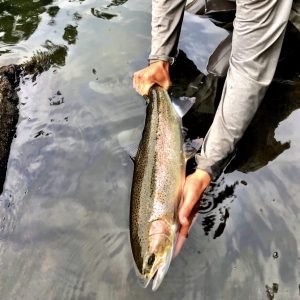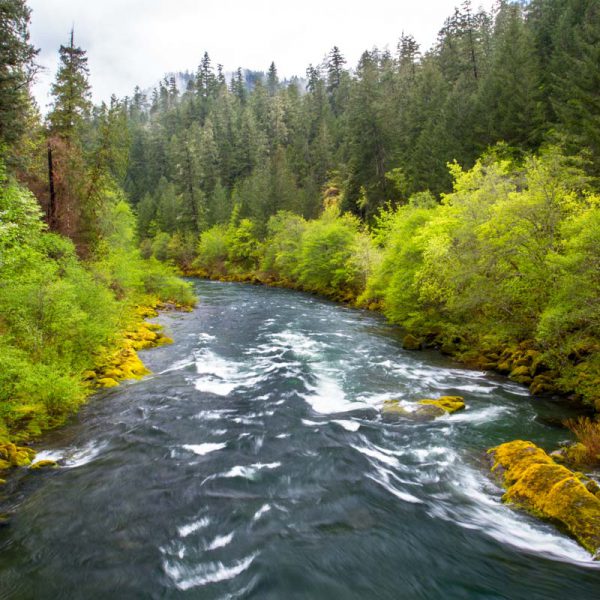
It’s official, only 449 Wild Summer Steelhead returned to the Iconic North Umpqua River last year, the lowest run on record. It is an emergency and we must take action to do everything we can to restore these fish.
For decades, conservationists, including legendary Steamboater Frank Moore, have been working to protect this fragile run of wild steelhead. Recently, the Steamboaters have been a part of the North Umpqua Coalition, a group of conservation organizations working together to restore an all wild steelhead North Umpqua. Our mission is simple – focus on the management practices we can control and we know work. In the North Umpqua, we don’t look far for answers because the river’s wild winter steelhead show us the way.
Three decades ago, fisheries managers elected to end hatchery releases of winter steelhead into the North Umpqua. They invested in habitat restoration after decades of extensive logging and managing winter steelhead for the wild genetics and diversity, not fish reared in other watersheds or concrete raceways. Since then, the run has seen a dramatic recovery. In 2020, ODFW reported over 10,000 fish crossing Winchester dam and in 2015 over 13,000 wild winter steelhead made the journey over the dilapidated dam. This, by far is the largest run of wild fish in the entire Northern Oregon Coast.
In 2020, the Archie Creek fire obliterated ODFW’s Rock Creek Hatchery in the Umpqua Basin. In response, ODFW moved hatchery programs to Cole Rivers hatchery on the Rogue River in Southern Oregon. After rearing there, those fish have been moved back up to the North Umpqua Basin.
The Coalition is asking ODFW to pause the planting of hatchery summer steelhead in the North Umpqua River starting this year. To be clear: we aren’t asking for an elimination of all hatchery programs in the basin, we are focused on the summer steelhead in the North Umpqua.
ODFW’s own monitoring shows that too many hatchery fish are spawning in the North Umpqua, and have been for decades. The Steamboaters are simply requesting that ODFW follow their own conservation management plan. This plan was adopted in 2014 to help restore and conserve multiple species of salmon, steelhead and cutthroat trout on the Northern Oregon Coast. It is absurd that ODFW will not comply or enforce their own rules and regulations in fisheries management.
To outline the science and give a historical perspective we go to Jeff Dose, current Steamboaters president, and retired fisheries biologist of the Umpqua National Forest. Jeff worked in the North Umpqua Basin for over thirty years and deeply understands the hydrology, biology, and ecology of the entire watershed. There’s no better person to provide insights on why a pause to the summer steelhead hatchery program is part of the solution to giving the North Umpqua’s iconic wild fish their best chance to rebuild their numbers.
A Change in Management for the Future of Wild Summer Steelhead
By Jeff Dose, Steamboaters President
The topic I’d like to address is what I clearly believe is a needed, and appropriate, change to the Coastal Multi-species Management Plan (CMP). Specifically, since adoption of the CMP, there has been some substantially changed conditions to the environment within the North Umpqua basin from the Archie Creek fire and accelerated climate change. There has also been a changed condition with the status of the wild summer steelhead population, with a substantial declining trend. I believe plan amendments are entirely appropriate. Changes from the original assumptions regarding wild NU summer steelhead involve both biological and environmental factors.
Habitat quality is already problematic in some parts of the watershed and will undoubtedly be further reduced from decreased water quality, sedimentation, simplification of stream channels from landslides, among other factors. The biological conditions are such that there has been a decline from the observed abundance of 3,200 from which the CMP is based, while counts of wild summers at Winchester Dam have actually declined to under 2,000 for 4 of the last 6 years, with the 2021 run at about 350, the lowest on record since counting began in 1946. This is a major movement away from the desired abundance and towards the critical abundance of 1,200 identified in the CMP. They are classed as Sensitive – Vulnerable and proactive management of existing threats is warranted. It was true then and new information supports the need for even greater actions. If information appears to show that progress is not being made towards desired status goals, or declining towards critical abundance levels, the ODFW will consider if additional actions need to be implemented. I strongly believe this is the case.
Please note that in an OAR for steelhead management goals there is direction to protect wild populations of steelhead from detrimental interactions with hatchery fish. The literature clearly shows that hatchery fish have the potential to cause either genetic or ecological (i.e, competition or predation) impacts on any population with which they spatially and temporally overlap. They certainly do overlap in the case of NU summer steelhead at both juvenile and adult life stages. The desired proportion of hatchery fish in the natural environment (pHOS) goal is to not exceed 10%. This is either unmet or not accurately measured and is estimated to be over 30%. Many of the returning hatchery summers counted at Winchester Dam are not accounted for in harvest or the Rock Creek trap. Some indication of where they go, and likely spawn, is counts at Soda Springs Dam, which is some 40 miles upstream from Rock Creek. In some years the number of hatchery summers has equaled and occasionally greatly exceeded wild summers.
The environmental and biological conditions affecting the long-term persistence and abundance of wild NU summer steelhead is putting them at great risk. The potential social and economic benefits from a robust run of wild NU summer steelhead is great but is threatened. One action that the ODFW and the Commission, can take to reverse this trajectory is to amend the CMP to eliminate the NU summer steelhead hatchery program. We are not asking for a complete cessation of all hatchery programs, just a pause in the NU summer steelhead hatchery program for 10 years, which equates to about two generations. It won’t solve all the threats but will go a long way towards that goal. One final thought, the genetic diversity inherent in a wild steelhead population will provide for greatly improved resiliency that will be needed to cope with the anticipated future changes in environmental factors. There is no better biological insurance policy.
On April 7th, ODFW will be hosting a webinar discussing the future of Summer Steelhead in the North Umpqua River. The webinar will feature Dr. Megan Jones, a social scientist with ODFW and a member of the ODFW science team. There will be a presenation followed by questions and answers. Please join to share your concerns about the future of Summer Steelhead in the North Umpqua River.
On April 22nd, the ODFW Commissioners will be reviewing the situation of North Upmqua Summer Steelhead. The Steamboaters will be at that commission meeting asking ODFW to comply with the Conservation Management Plan adopted in 2014. Please join us in person that day or over the phone testifying to the Commission.

